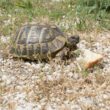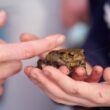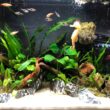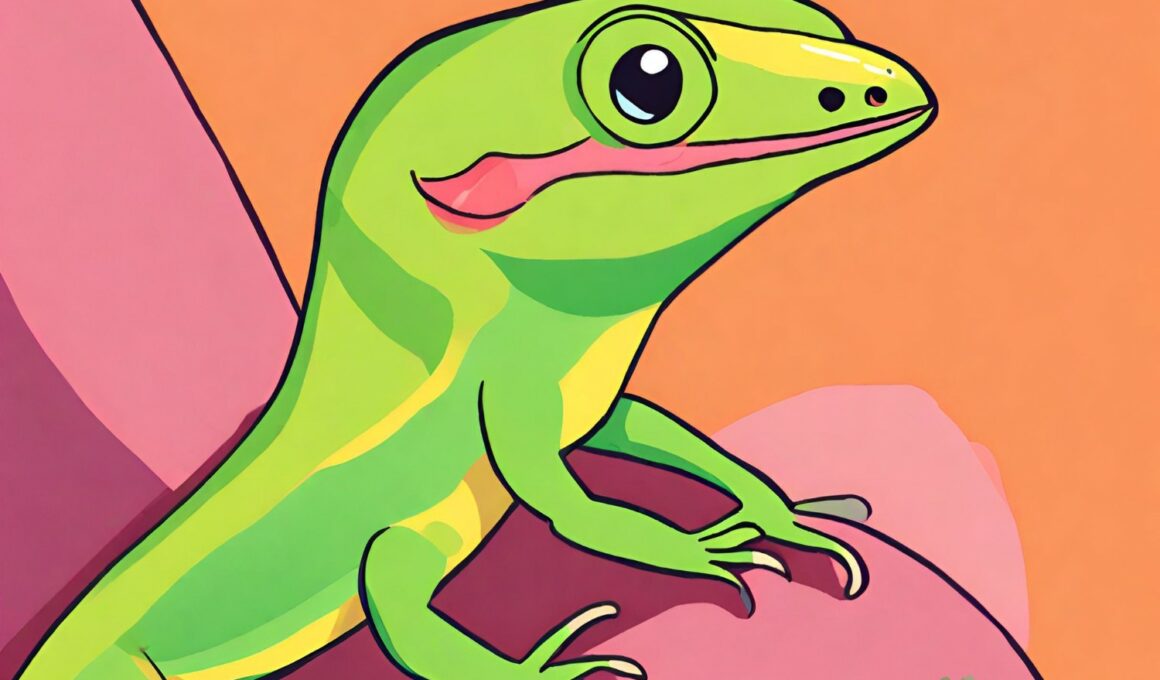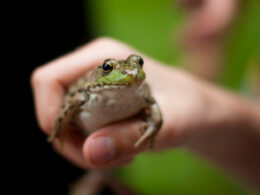In this article Show
These little creatures, with their captivating behavior and dynamic displays of color, have grabbed the attention of many pet lovers, myself included. When I’m not working or taking care of my array of reptiles, I’m usually buried in a book, expanding my knowledge of these fascinating beings.
You might be wondering, “Why Anole Lizards?” Well, besides their undeniable charm, Anole Lizards are among some of the most popular reptile pets. They’re often recommended for beginners due to their manageable size and relatively straightforward care requirements. But like all pets, they come with their unique set of needs.
In this comprehensive guide, we’ll go through all you need to know to provide the best care for your Anole Lizard. From setting up the perfect terrarium to understanding their dietary needs, we’ve got it all covered.
So, whether you’re just considering getting one or already have an Anole crawling around in its terrarium, stick around. There’s always something new to learn about these mesmerizing creatures. Let’s embark on this enlightening journey together.
Understanding the Different Species of Anole Lizards
Before diving into the details of each species, it’s important to recognize the diversity within the Anole family. They’re not just a one-size-fits-all kind of reptile. Different Anoles have unique characteristics, habitats, and care requirements.
According to a study published in the journal Nature in 2018, Anoles are a highly diverse group with over 400 species found predominantly in the Americas. This incredible diversity offers a peek into the vast world of reptiles and highlights the need for tailored care depending on the species in question.
Let’s take a closer look at some of the more popular Anole species kept as pets:
1. Green Anole (Anolis carolinensis)
Native to the southeastern United States, this species is known for its vibrant green color, though it can change to brown depending on its mood and environment. They’re often mistaken for chameleons due to their color-changing ability.
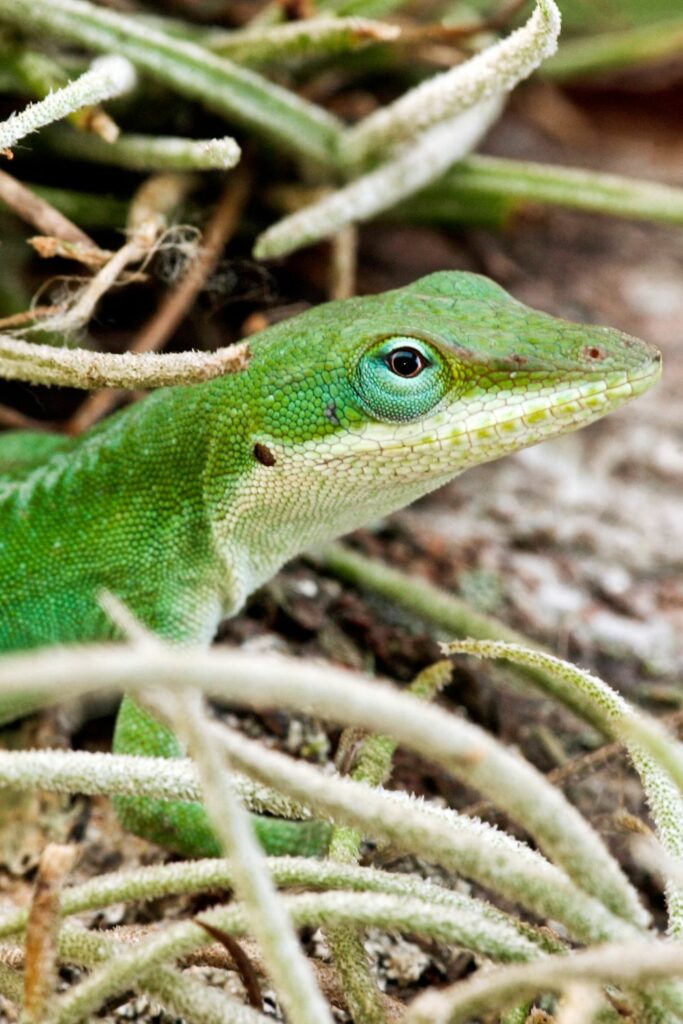
2. Brown Anole (Anolis sagrei)
Originally from Cuba and the Bahamas, these lizards have now established themselves in various parts of the USA, particularly Florida. Recognized by their brown color, males often display a reddish or orangey dewlap.
3. Knight Anole (Anolis equestris)
The largest of the Anole species, Knight Anoles are native to Cuba. They’re known for their vibrant green coloration and can grow up to 20 inches in length. Due to their size, they require a bit more space than their counterparts.
4. Cuban Green Anole (Anolis porcatus)
Often mistaken for the Green Anole, the Cuban Green Anole is, as the name suggests, native to Cuba. While they share similarities in appearance, subtle differences in size and behavior can help distinguish them.
Each of these species, with their distinct personalities and needs, contributes to the rich experience of keeping Anole Lizards. As we delve deeper into their care, it’s essential to keep their requirements in mind.
Setting Up the Perfect Anole Terrarium
Creating an ideal environment for your Anole Lizard is crucial. A properly set up terrarium not only ensures their health and well-being but also allows you to observe their natural behaviors in a replicated habitat. Here’s how you can go about establishing that perfect space for your Anole:
1. Choosing the Right Size
Anoles are active climbers and require vertical space. A 20-gallon tall terrarium is often recommended for a single Anole, with additional space added if you plan on housing more. Remember, more space is always better; it gives them room to explore and exercise.
2. The Ideal Substrate
The substrate forms the base of your terrarium. For Anoles, a mix of coconut coir and orchid bark works well. These retain moisture, helping maintain humidity, and are also easy to clean. Avoid substrates like sand or gravel, which can be ingested and lead to impaction.
3. Decoration and Hiding Spots
Anoles, being arboreal, love to climb. Incorporate branches, vines, and live or artificial plants to provide them with vertical structures. Also, they appreciate hiding spots like cork bark, hollowed logs, or leaves to retreat to when they feel the need for some privacy.
4. Proper Lighting and Heating Equipment
Lighting is crucial for Anoles. A UVA/UVB bulb helps in synthesizing vitamin D3, which in turn aids in calcium absorption. For heating, a basking light or ceramic heat emitter can be used. Aim for a basking spot of around 85°F (29°C) and a cooler side of the terrarium at about 75°F (24°C).
5. Maintaining Humidity
Anoles thrive in a humid environment. A humidity level of 60-70% is ideal. This can be achieved by misting the terrarium once or twice daily and using a substrate that retains moisture.
Having a hygrometer in the terrarium can help you monitor the humidity levels. Remember, consistent humidity is vital for successful shedding.
Setting up a terrarium might sound a tad technical, but it’s much like designing a little slice of nature inside your home.
By paying attention to these key aspects, you ensure that your Anole Lizard has everything it needs to live a happy, healthy life. And in return, you get to enjoy the beauty and intrigue they bring to your space.
Diet and Nutrition
A well-balanced diet is paramount to the health and longevity of your Anole Lizard. Their specific dietary needs reflect their insectivorous nature, which means they primarily feed on insects. Let’s explore the key components of an Anole’s diet and nutrition:
Understanding Their Insectivorous Nature
Anoles have evolved to be skilled insect hunters. In the wild, their diet consists mainly of small insects, which they actively stalk and consume. This predatory behavior is not just about nourishment; it also provides mental stimulation and exercise, making it essential to replicate in captivity.
Commonly Fed Insects and Occasional Treats
Crickets are the staple diet for most captive Anoles due to their nutritional value and availability. However, it’s beneficial to offer a varied diet.
Other insects like mealworms, waxworms, and fruit flies can be added to their menu. For an occasional treat, you might consider earthworms or moths.
Remember, the size of the insect should be proportionate to the Anole’s size. A good rule of thumb is not to offer prey larger than the distance between the Anole’s eyes.
Supplements and Vitamins
While insects form the core of their diet, supplements ensure they get all the necessary nutrients. Calcium powder, ideally with Vitamin D3, should be used to dust the insects before feeding. This is vital for bone health. Additionally, a multivitamin supplement can be offered once a week.
Hydration
Anoles don’t typically drink from standing water. Instead, they prefer to lap up water droplets from leaves or the terrarium walls. This makes misting not only essential for maintaining humidity but also for their hydration.
Ensure fresh water is always available, either by daily misting or by placing a shallow water dish, even if they might not use the latter frequently.
Feeding time can be a delightful experience, watching your Anole actively hunt and gobble down its prey. With the right diet and nutritional supplements, your lizard will display vibrant colors, exhibit active behaviors, and lead a long, healthy life.
Remember, the key is variety and balance. Just like us, they too thrive on a diet that offers diverse nutrients.
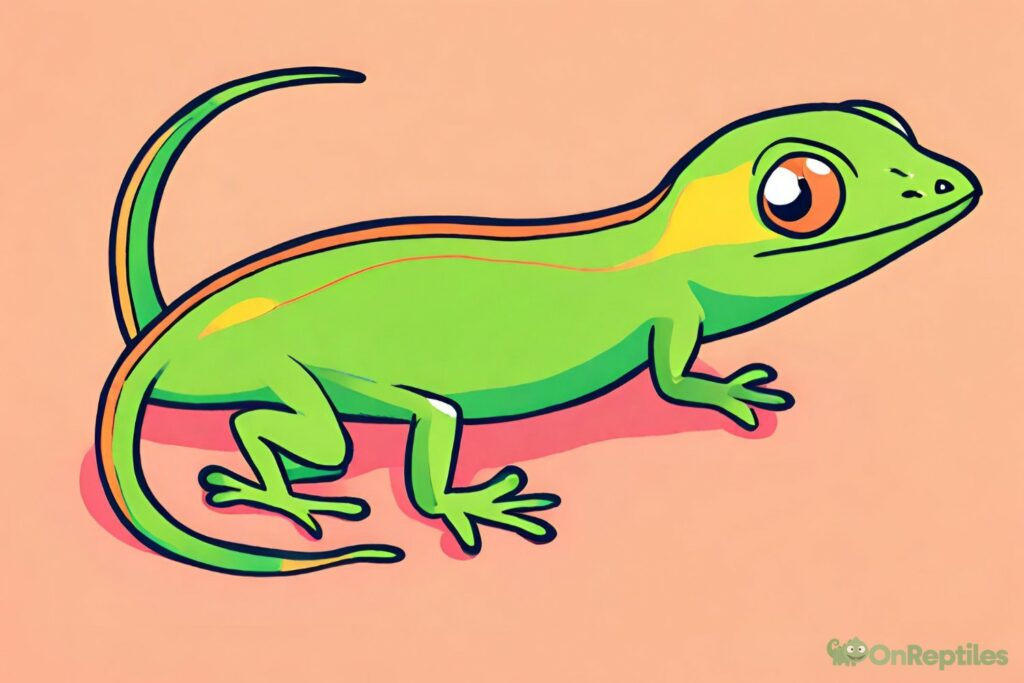
Social and Behavioral Aspects
Understanding the social and behavioral nuances of Anole Lizards can significantly enhance the care you provide. It can also help preempt issues before they escalate. Here’s a closer look into the social dynamics and behaviors of these intriguing creatures:
Males vs. Females: Territory and Aggression
Males
Known to be territorial, male Anoles often display dominant behaviors like extending their dewlaps, bobbing their heads, and puffing themselves up. It’s not recommended to house multiple males together, as this can lead to constant aggression and stress.
Females
Generally more docile, female Anoles can coexist together, although occasional spats can arise. It’s essential to provide enough space and hiding spots to minimize conflicts. When males and females are housed together, be prepared for potential breeding.
Interaction with Other Species
Co-habitation with other reptile species is generally not advised. Anoles have specific needs, and their active, territorial nature might not mesh well with other species. If considering a community setup, always research thoroughly and ensure compatibility.
Remember, even within Anoles, different species might have distinct requirements and temperaments. Mixing them without adequate knowledge can lead to undue stress and potential conflicts.
Signs of Stress and How to Alleviate It
Signs to Look Out For
Darkening of color, decreased appetite, lethargy, frequent hiding, and erratic movements can indicate stress.
Addressing Stress
Identify the cause. It could be due to inadequate terrarium conditions, the presence of predators (even outside the terrarium, like household pets), or internal issues like parasites.
Ensure the terrarium setup meets their needs, particularly in terms of temperature, humidity, and hiding spots. If behavioral issues persist, consider consulting a reptile veterinarian.
Recognizing and respecting the social and behavioral needs of your Anole Lizard is paramount. These are not just facets of their personality; they’re rooted deeply in their instincts and evolutionary history.
By fostering an environment that aligns with these instincts, you not only ensure their well-being but also get to witness a captivating display of natural behaviors.
Healthcare and Common Diseases
Just like any other pet, Anole Lizards are susceptible to certain health conditions. Recognizing early signs of distress and being proactive about their health can go a long way in ensuring they lead a long, fulfilling life.
According to a publication by the Association of Reptilian and Amphibian Veterinarians, regular health checks and early intervention can significantly improve the prognosis for reptiles. Anoles, with their specific set of needs, are no exception. Keeping this in mind, let’s delve into understanding their healthcare:
Signs of a Healthy Anole

- Active Behavior: Healthy Anoles are curious and alert. Regular movement, active hunting, and climbing behaviors indicate good health.
- Consistent Eating Habits: They should have a steady appetite, and show interest in their food.
- Clear Eyes: Eyes should be bright, clear, and free from discharge.
- Smooth Skin: While shedding is a regular part of their lifecycle, the skin, in general, should be free from sores, blisters, or patches.
- Regular Bowel Movements: Excrement should be consistent and not overly watery.
Common Diseases and Treatments
Metabolic Bone Disease (MBD)
As a result of calcium and vitamin D3 deficiency, signs include weak, brittle bones, and a rubbery jaw. Ensuring proper UVB lighting and calcium supplementation can prevent this. If suspected, seek veterinary attention immediately.
Parasites
Internal parasites can cause symptoms like weight loss, decreased appetite, and abnormal feces. External parasites, like mites, can cause skin issues. Regularly clean the terrarium and monitor your Anole. If parasites are suspected, a vet can provide appropriate treatments.
When to See a Vet
- Regular Check-ups: Even if your Anole appears healthy, annual check-ups can help preempt potential issues.
- Visible Distress: If your Anole exhibits signs of distress, like erratic behavior, labored breathing, or lethargy, it’s crucial to consult a vet.
- Dietary Changes: A sudden loss of appetite or change in bowel movements warrants veterinary attention.
- Physical Abnormalities: Swellings, lumps, wounds, or any abnormal physical appearance should be checked by a professional.
In summary, being observant and proactive about your Anole’s health is vital. These creatures, while resilient, rely on us to create an environment conducive to their well-being.
With proper care, regular checks, and a keen eye for early signs of distress, you can ensure your Anole thrives in your care.
Breeding and Reproduction
Breeding Anole Lizards can be an exciting endeavor, offering enthusiasts a chance to witness the full life cycle of these fascinating creatures.
If you’re considering breeding Anoles, understanding the intricacies of their reproductive behaviors and requirements is crucial. Let’s delve into the world of Anole breeding:
Determining the Gender
Males
They possess a larger and more noticeable dewlap, which is the flap of skin under their neck. Males use this to display dominance and attract females. Additionally, males often have enlarged post-anal scales (located near the base of the tail).
Females
Their dewlap is smaller, and they lack the enlarged post-anal scales. Another distinguishing feature is the presence of a white line running down their back, which most males lack.
Setting Up a Breeding Environment
Terrarium
While the standard terrarium setup remains largely the same, you may want to provide additional hiding spots to reduce stress. This is especially important if you’re introducing a new mate.
Temperature
A slight increase in temperature can stimulate breeding behavior. However, ensure it’s within the safe range (basking areas around 87-90°F or 31-32°C).
Introducing the Pair
It’s advisable to introduce the female to the male’s territory. Monitor their interaction. While initial skirmishes or displays are normal, if aggressive behavior persists, consider separating and reintroducing them later.
Egg Incubation and Care
- Laying Sites: Females often choose secluded, moist spots to lay their eggs. Providing a laying box filled with damp sphagnum moss or vermiculite can encourage this.
- Egg Retrieval: Once the female lays eggs, they can be carefully transferred to an incubation container. This should have a substrate like vermiculite, kept moist but not wet.
- Incubation: Eggs should be kept at a consistent temperature, ideally between 80-84°F (27-29°C). They shouldn’t be rotated or turned.
- Hatching: In 5-7 weeks, the eggs should hatch. Hatchlings can be carefully transferred to a separate, well-prepared terrarium with appropriate food, temperature, and humidity.
Breeding Anoles provides an opportunity to witness the miracle of life, from egg to hatchling. However, it’s a responsibility that demands careful planning, attention to detail, and commitment. With the right approach and a touch of patience, you can successfully breed and raise a new generation of these captivating lizards.
Handling and Taming Your Anole
Building trust and understanding with your Anole lizard is vital, especially if you wish to handle them. While these creatures are not as domesticated as some other pets, with patience and care, they can become accustomed to gentle handling. Here’s a guide to forging that bond:
The Right Way to Approach and Handle
- Slow and Steady: Quick movements can be threatening to Anoles. When you’re about to handle them, move slowly and deliberately.
- Open Palm Approach: Instead of grabbing, allow the Anole to walk onto your hand. This way, they feel in control and less threatened.
- Gentle Grip: If you do need to grip your Anole, gently hold them around the mid-body. Never grab them by the tail, as Anoles can drop their tails as a defense mechanism.
- Limit Handling Time: Initially, limit handling sessions to a few minutes. Gradually increase the time as your Anole becomes more accustomed.
Bonding with Your Pet
- Frequent Interaction: Spend time near the terrarium, talking softly or just being present. This gets your Anole accustomed to your presence.
- Treat Reinforcement: Offer their favorite treat after a successful handling session. Over time, they’ll associate handling with positive experiences.
- Predictable Routine: Anoles thrive on routine. Try to handle them at the same time each day to build consistency.

Safety Precautions
- Wash Your Hands: Always wash your hands before and after handling to prevent the spread of germs.
- Avoid Face Contact: While they’re not known to carry diseases like salmonella, it’s still a good practice to avoid letting them near your face.
- Supervised Sessions: If you’re letting the Anole out of its terrarium, always supervise to prevent accidents or potential escape.
- Be Aware of Stress Signs: If your Anole darkens its color, becomes overly aggressive, or tries to flee constantly, it might be stressed. In such cases, give it some space and time to relax before trying again.
- Environment: Ensure the room is safe, devoid of potential threats like other pets, and that windows and doors are closed.
Building a bond with your Anole requires patience, consistency, and an understanding of their behavior. Remember, each Anole is unique. While some may take to handling quickly, others might require more time.
It’s crucial to go at a pace that’s comfortable for both you and your pet, ensuring every interaction is a positive experience.

